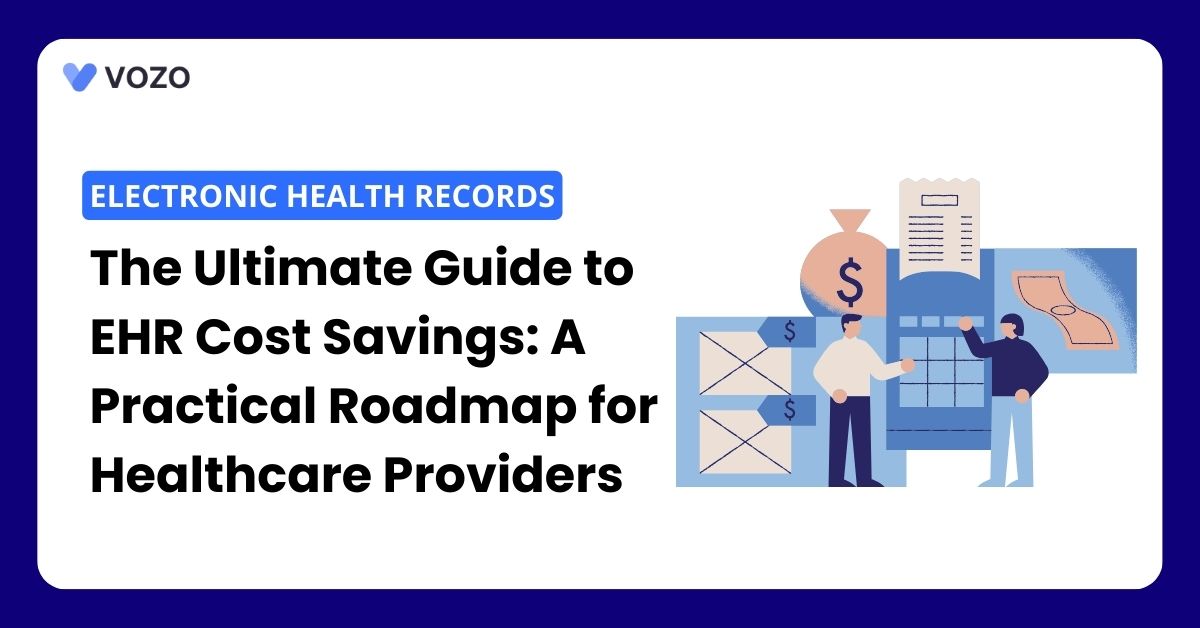The Ultimate Guide to EHR Cost Savings: A Practical Roadmap for Healthcare Providers
Electronic health records (EHRs) have become integral to healthcare delivery in recent years. However, the costs associated with implementing and maintaining EHR systems can be substantial for many providers.
According to a study by The Office of the National Coordinator for Health Information Technology, the average cost of purchasing and implementing an EHR system is $48,000 per physician. Ongoing costs add $10,000 per physician per year.
With rising healthcare costs and shrinking reimbursements, finding ways to realize EHR cost savings has become a priority for many healthcare organizations.
This guide provides a practical roadmap to help healthcare providers control EHR expenses while still harnessing the clinical and financial benefits these systems offer.
Recent Trends Driving the Need for Cost Savings
In 2023, CMS announced plans to further reduce Medicare reimbursement rates by 3.5%, continuing a decade-long trend of cuts to provider payments. Additionally, metrics such as hospital readmission rates and hospital-acquired infection rates are being incorporated into reimbursement formulas, financially penalizing healthcare facilities.
Adoption of EHRs and demonstration of “meaningful use” of health IT systems is also tied to reimbursement rates, further straining IT budgets.
Related: Know The Cost Of Developing A Patient Portal In Minutes
Benefits of EHR Systems
While EHR costs are substantial, these systems offer significant benefits:
- Improved clinical decision-making and reduced errors due to better access to patient data
- Increased patient engagement through patient portals and enhanced communication
- Notes are legible and available remotely securing continuity of care
- Instantaneous data analytics on individual and population health metrics
- Streamlined regulatory compliance
- Reduced transcription expenses
According to a Stanford Medicine study, EHR use led to a 6-10% decrease in patient mortality. Financial benefits such as reduced transcription fees and improved charge capture reportedly offset initial costs within 3-5 years.
Roadmap for Realizing Cost Savings
When approaching EHR deployment or optimization, focusing on a few key areas can keep expenses under control:
1. Accurate Organizational Needs Assessment
2. Strategic System Selection and Price Negotiation
3. Workflow Optimization
4. Cost-Effective IT Infrastructure
5. Ongoing Maintenance and Staff Development
Here is a checklist of critical actions under each area:
| Area | Action Items |
| Needs Assessment | – Compare systems through demos and peer recommendations. – Leverage vendor competition to get the best pricing. – Negotiate favorable contract terms on hardware, software, maintenance, and payment structure |
| System Selection | – Compare systems through demos and peer recommendations. – Leverage vendor competition to get the best pricing. – Negotiate favorable contract terms on hardware, software, maintenance, and payment structure. |
| Workflow Optimization | – Eliminate redundant screens and clicks. – Enable the use of note templates, macros, and shortcuts. – Identify opportunities for automation through interfaces and smart forms. |
| IT Infrastructure | – Choose cloud-based EHR for predictable, affordable IT expenses. – Utilize mobile devices rather than desktop workstations. – Ensure uptime through a disaster recovery plan. |
| Maintenance & Staff Development | – Keep systems, hardware, and integrations up-to-date. – Continually train staff on optimal EHR use and new functionalities. |
While the EHR optimization process requires an investment of time and effort, the long-term cost savings and practice benefits are well worth it.
Paying attention to the roadmap outlined above will help healthcare organizations select the right EHR at the best price and maximize clinical and financial returns on their investment.
The key is working with both IT leaders and clinicians to improve workflows while keeping technical infrastructure costs under control continuously. This ability to adapt and optimize is critical in today’s rapidly changing healthcare environment.
Related: Emerging Trends in Cloud-Based EHR Solutions: Shaping the Future of Healthcare Technology
Bring Efficiency, Insights, and Savings to Your Practice with Vozo EHR
Vozo EHR stands out for its user-friendly interface, seamless integration, and robust analytics. Our clients consistently experience cost savings and heightened productivity with Vozo:
- Intuitive interfaces mean less training time and faster user adoption
- Seamless integration with major labs, pharmacies, billing systems, and telehealth platforms
- Customizable templates, workflows, alerts, and notifications to enhance clinician productivity
- Robust analytics tools including custom reports, population health management, and risk stratification
Vozo offers top-notch quality at affordable prices, ensuring superior value compared to traditional models. Whether you’re adopting your first EHR or upgrading, Vozo is your partner for clinical excellence and financial optimization.
About the author

With more than 4 years of experience in the dynamic healthcare technology landscape, Sid specializes in crafting compelling content on topics including EHR/EMR, patient portals, healthcare automation, remote patient monitoring, and health information exchange. His expertise lies in translating cutting-edge innovations and intricate topics into engaging narratives that resonate with diverse audiences.













